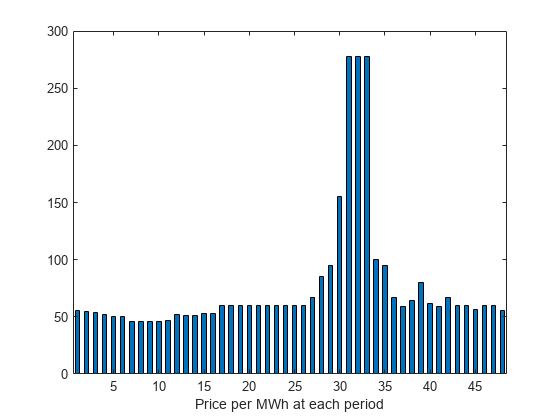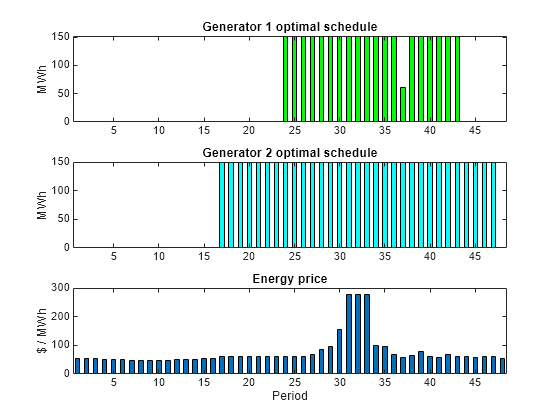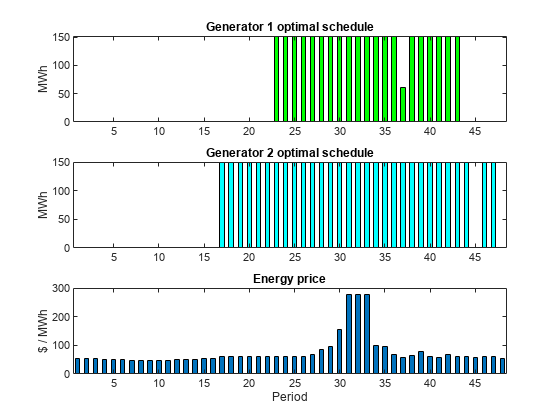发电机的最佳调度:基于求解器
此示例说明如何以最佳方式调度两台燃气发电机,即收益减去成本的值最大。虽然此示例并不完全切合实际,但它能够说明如何考虑取决于决策时机的成本。
要了解如何通过基于问题的方法处理此问题,请参阅发电机的最佳调度:基于问题。
问题定义
电力市场在一天的不同时段有不同用电价格。如果您有发电机,您可以利用这种可变定价,通过安排发电机在价格高的时候运行。假设您控制两台发电机。每台发电机有三个功率水平(关、低和高)。每台发电机在每个功率水平下都有指定的燃料消耗率和发电量。当然,当发电机关闭时,燃料消耗为 0。
您可以在一天中的每个半小时时间间隔(24 小时,因此 48 个间隔)为每个发电机分配一个功率级别。根据历史记录,您可以假设您知道每个时间间隔内每兆瓦时 (MWh) 的收入。此示例的数据来自澳大利亚能源市场运营商 https://www.nemweb.com.au/REPORTS/CURRENT/ 2013 年中报告,数据的使用遵守其条款 https://www.aemo.com.au/privacy-and-legal-notices/copyright-permissions。
load dispatchPrice; % Get poolPrice, which is the revenue per MWh bar(poolPrice,.5) xlim([.5,48.5]) xlabel('Price per MWh at each period')

发电机关闭后启动是有成本的。另一个约束是当天的最大燃料使用量。最大燃料约束是因为您提前一天购买燃料,所以只能使用刚购买的燃料。
问题表示和参数
您可以将调度问题构造为一个二元整数规划问题,如下所示。将索引 i、j 和 k 以及二元调度向量 y 定义为:
nPeriods= 时间段数,本例中为 48。i= 一个时间段,1 <=i<= 48。对于此示例,
j= 发电机索引,1 <=j<= 2。在时间段
i中,发电机j在功率水平k上运行,表示为y(i,j,k) = 1。让低功率为k = 1,高功率为k = 2。当sum_k y(i,j,k) = 0时,发电机关闭。
您需要确定发电机关闭后何时启动。假设
发电机
j在时间段i关闭,但在时间段i + 1打开,表示为z(i,j) = 1。在其他时间段z(i,j) = 0。换句话说,当sum_k y(i,j,k) = 0时z(i,j) = 1,且sum_k y(i+1,j,k) = 1。
显然,您需要一种方法来根据 z 的设置自动设置 y。以下线性约束可处理此设置。
您还需要成本问题的参数、每台发电机的发电水平、发电机的燃料消耗水平和可用燃料。
poolPrice(i)-i间隔内每兆瓦时收入(美元)。gen(j,k)- 由发电机j在功率等级k下产生的兆瓦。fuel(j,k)- 发电机j在功率等级k下使用的燃料。totalfuel- 一天内可用的燃料。startCost- 发电机关闭后再启动的成本(美元)。fuelPrice- 每单位燃料的成本。
当您执行 load dispatchPrice; 时,您得到 poolPrice。按如下所示设置其他参数。
fuelPrice = 3; totalfuel = 3.95e4; nPeriods = length(poolPrice); % 48 periods nGens = 2; % Two generators gen = [61,152;50,150]; % Generator 1 low = 61 MW, high = 152 MW fuel = [427,806;325,765]; % Fuel consumption for generator 2 is low = 325, high = 765 startCost = 1e4; % Cost to start a generator after it has been off
发电机效率
检查两台发电机在两个工作点的效率。
efficiency = gen./fuel; % Calculate electricity per unit fuel use rr = efficiency'; % for plotting h = bar(rr); h(1).FaceColor = 'g'; h(2).FaceColor = 'c'; legend(h,'Generator 1','Generator 2','Location','NorthEastOutside') ax = gca; ax.XTick = [1,2]; ax.XTickLabel = {'Low','High'}; ylim([.1,.2]) ylabel('Efficiency')

请注意,发电机 2 在其相应的工作点(低或高)下比发电机 1 稍微高效一些,但发电机 1 在其高工作点下比发电机 2 在其低工作点下更高效。
解的变量
要设置问题,您需要以 intlinprog 求解器所需的形式对所有问题数据和约束进行编码。您有代表问题解的变量 y(i,j,k) 和用于充电以启动发电机的 z(i,j) 辅助变量。y 是一个 nPeriods-by-nGens-by-2 数组,而 z 是一个 nPeriods-by-nGens 数组。
为了将这些变量放入一个长向量中,定义未知变量 x:
x = [y(:);z(:)];
对于边界和线性约束,最简单的方法是使用 y 和 z 的自然数组表示,然后将约束转换为总决策变量,即向量 x。
边界
解向量 x 由二元变量组成。设置边界 lb 和 ub。
lby = zeros(nPeriods,nGens,2); % 0 for the y variables lbz = zeros(nPeriods,nGens); % 0 for the z variables lb = [lby(:);lbz(:)]; % Column vector lower bound ub = ones(size(lb)); % Binary variables have lower bound 0, upper bound 1
线性约束
对于线性约束 A*x <= b,A 矩阵的列数必须与 x 的长度相同,又与 lb 的长度相同。要创建适当大小的 A 行,请创建 y 和 z 矩阵大小的零矩阵。
cleary = zeros(nPeriods,nGens,2); clearz = zeros(nPeriods,nGens);
为了确保功率水平不超过一个等于 1 的分量,设置线性不等式约束:
x(i,j,1) + x(i,j,2) <= 1
A = spalloc(nPeriods*nGens,length(lb),2*nPeriods*nGens); % nPeriods*nGens inequalities counter = 1; for ii = 1:nPeriods for jj = 1:nGens temp = cleary; temp(ii,jj,:) = 1; addrow = [temp(:);clearz(:)]'; A(counter,:) = sparse(addrow); counter = counter + 1; end end b = ones(nPeriods*nGens,1); % A*x <= b means no more than one of x(i,j,1) and x(i,j,2) are equal to 1
每个期间的运行成本是该期间的燃料成本。对于在 k 水平上运行的发电机 j,成本为 fuelPrice * fuel(j,k)。
为了确保发电机不会消耗过多的燃料,对燃料使用总量创建不等式约束。
yFuel = lby; % Initialize fuel usage array yFuel(:,1,1) = fuel(1,1); % Fuel use of generator 1 in low setting yFuel(:,1,2) = fuel(1,2); % Fuel use of generator 1 in high setting yFuel(:,2,1) = fuel(2,1); % Fuel use of generator 2 in low setting yFuel(:,2,2) = fuel(2,2); % Fuel use of generator 2 in high setting addrow = [yFuel(:);clearz(:)]'; A = [A;sparse(addrow)]; b = [b;totalfuel]; % A*x <= b means the total fuel usage is <= totalfuel
设置发电机启动指示变量
如何让求解器自动设置 z 变量来匹配 y 变量所代表的活动/关闭周期?回想一下,要满足的条件是当且仅当满足以下条件时 z(i,j) = 1:
sum_k y(i,j,k) = 0 和 sum_k y(i+1,j,k) = 1。
请注意
当您想要 sum_k ( - y(i,j,k) + y(i+1,j,k) ) > 0 时恰好是 z(i,j) = 1。
因此,包括线性不等式约束
sum_k ( - y(i,j,k) + y(i+1,j,k) ) - z(i,j) < = 0
在问题表示中,并将 z 变量纳入目标函数成本中。通过将 z 变量纳入目标函数,求解器尝试降低 z 变量的值,这意味着它尝试将它们全部设置为 0。但是对于发电机启动的间隔,线性不等式迫使 z(i,j) 等于 1。
在线性不等式约束矩阵 A 中添加额外的行来表示这些新的不等式。将时间回绕,以便间隔 1 在逻辑上跟在间隔 48 之后。
tempA = spalloc(nPeriods*nGens,length(lb),2*nPeriods*nGens); counter = 1; for ii = 1:nPeriods for jj = 1:nGens temp = cleary; tempy = clearz; temp(ii,jj,1) = -1; temp(ii,jj,2) = -1; if ii < nPeriods % Intervals 1 to 47 temp(ii+1,jj,1) = 1; temp(ii+1,jj,2) = 1; else % Interval 1 follows interval 48 temp(1,jj,1) = 1; temp(1,jj,2) = 1; end tempy(ii,jj) = -1; temp = [temp(:);tempy(:)]'; % Row vector for inclusion in tempA matrix tempA(counter,:) = sparse(temp); counter = counter + 1; end end A = [A;tempA]; b = [b;zeros(nPeriods*nGens,1)]; % A*x <= b sets z(i,j) = 1 at generator startup
约束稀疏性
如果您遇到大问题,使用稀疏约束矩阵可以节省内存,也可以节省计算时间。约束矩阵 A 相当稀疏:
filledfraction = nnz(A)/numel(A)
filledfraction = 0.0155
intlinprog 接受稀疏线性约束矩阵 A 和 Aeq,但要求它们对应的向量约束 b 和 beq 是满的。
定义目标
目标函数包括运行发电机的燃料成本、运行发电机的收入和启动发电机的成本。
generatorlevel = lby; % Generation in MW, start with 0s generatorlevel(:,1,1) = gen(1,1); % Fill in the levels generatorlevel(:,1,2) = gen(1,2); generatorlevel(:,2,1) = gen(2,1); generatorlevel(:,2,2) = gen(2,2);
收入 = x.*generatorlevel.*poolPrice
revenue = generatorlevel; % Allocate revenue array for ii = 1:nPeriods revenue(ii,:,:) = poolPrice(ii)*generatorlevel(ii,:,:); end
总燃料成本 = y.*yFuel*fuelPrice
fuelCost = yFuel*fuelPrice;
启动成本 = z.*ones(size(z))*startCost
starts = (clearz + 1)*startCost;
starts = starts(:); % Generator startup cost vector向量 x = [y(:);z(:)]。以 x 的形式写出总利润:
利润=收入-燃料总成本-启动成本
f = [revenue(:) - fuelCost(:);-starts]; % f is the objective function vector求解问题
为了节省空间,请隐藏迭代输出。
options = optimoptions('intlinprog','Display','final'); [x,fval,eflag,output] = intlinprog(-f,1:length(f),A,b,[],[],lb,ub,options);
Optimal solution found. Intlinprog stopped because the objective value is within a gap tolerance of the optimal value, options.RelativeGapTolerance = 0.0001. The intcon variables are integer within tolerance, options.ConstraintTolerance = 1e-06.
检查解
检查解的最简单方法是将解向量 x 分成它的两个分量 y 和 z。
ysolution = x(1:nPeriods*nGens*2); zsolution = x(nPeriods*nGens*2+1:end); ysolution = reshape(ysolution,[nPeriods,nGens,2]); zsolution = reshape(zsolution,[nPeriods,nGens]);
将解绘制为时间的函数。
subplot(3,1,1) bar(ysolution(:,1,1)*gen(1,1)+ysolution(:,1,2)*gen(1,2),.5,'g') xlim([.5,48.5]) ylabel('MWh') title('Generator 1 optimal schedule','FontWeight','bold') subplot(3,1,2) bar(ysolution(:,2,1)*gen(2,1)+ysolution(:,2,2)*gen(2,2),.5,'c') title('Generator 2 optimal schedule','FontWeight','bold') xlim([.5,48.5]) ylabel('MWh') subplot(3,1,3) bar(poolPrice,.5) xlim([.5,48.5]) title('Energy price','FontWeight','bold') xlabel('Period') ylabel('$ / MWh')

发电机 2 比发电机 1 运行时间长,这是您所期望的结果,因为这样效率更高。发电机 2 只要处于运行状态就以其高功率水平运行。发电机 1 主要在其高功率水平下运行,但在一个时间单位内降至低功率。每个发电机每天运行一组连续的时间段,因此仅产生一次启动成本。
检查在发电机启动的时间段内 z 变量是否为 1。
starttimes = find(round(zsolution) == 1); % Use round for noninteger results
[theperiod,thegenerator] = ind2sub(size(zsolution),starttimes)theperiod = 2×1
23
16
thegenerator = 2×1
1
2
发电机启动的时间段与绘图相匹配。
与启动罚分较低的情况进行比较
如果选择较小的 startCost 值,则解将涉及多个发电周期。
startCost = 500; % Choose a lower penalty for starting the generators starts = (clearz + 1)*startCost; starts = starts(:); % Start cost vector fnew = [revenue(:) - fuelCost(:);-starts]; % New objective function [xnew,fvalnew,eflagnew,outputnew] = ... intlinprog(-fnew,1:length(fnew),A,b,[],[],lb,ub,options);
Optimal solution found. Intlinprog stopped because the objective value is within a gap tolerance of the optimal value, options.RelativeGapTolerance = 0.0001. The intcon variables are integer within tolerance, options.ConstraintTolerance = 1e-06.
ysolutionnew = xnew(1:nPeriods*nGens*2); zsolutionnew = xnew(nPeriods*nGens*2+1:end); ysolutionnew = reshape(ysolutionnew,[nPeriods,nGens,2]); zsolutionnew = reshape(zsolutionnew,[nPeriods,nGens]); subplot(3,1,1) bar(ysolutionnew(:,1,1)*gen(1,1)+ysolutionnew(:,1,2)*gen(1,2),.5,'g') xlim([.5,48.5]) ylabel('MWh') title('Generator 1 optimal schedule','FontWeight','bold') subplot(3,1,2) bar(ysolutionnew(:,2,1)*gen(2,1)+ysolutionnew(:,2,2)*gen(2,2),.5,'c') title('Generator 2 optimal schedule','FontWeight','bold') xlim([.5,48.5]) ylabel('MWh') subplot(3,1,3) bar(poolPrice,.5) xlim([.5,48.5]) title('Energy price','FontWeight','bold') xlabel('Period') ylabel('$ / MWh')

starttimes = find(round(zsolutionnew) == 1); % Use round for noninteger results
[theperiod,thegenerator] = ind2sub(size(zsolution),starttimes)theperiod = 3×1
22
16
45
thegenerator = 3×1
1
2
2